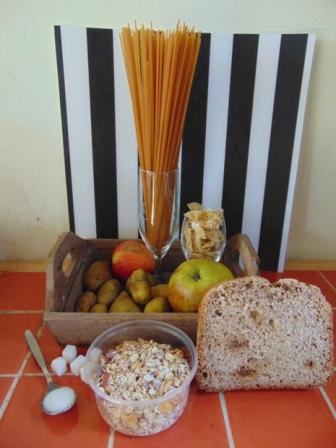Alcohol provides many calories but not is really (or really not) necessary for the body.
 Proteins are the building blocks of the body. They're in dairy, meat, fish, eggs, legumes, etc. and are usually high in fat. Also grains, nuts and seeds are a rich source of protein.
Proteins are the building blocks of the body. They're in dairy, meat, fish, eggs, legumes, etc. and are usually high in fat. Also grains, nuts and seeds are a rich source of protein.
So far 1 million different proteins have been discovered. They all consist of 20 of the hundreds of naturally occurring amino acids. A small, indefinite number of contiguous amino acids is called a peptide. Per 10 or 12 that becomes a polypeptide. The even larger ones are called proteins.
There are complex carbohydrates (starch, such as potatoes, whole grain rice or pasta,...) and simple carbohydrates, including the natural sugars (e.g. in fruit) and added sugars.
Unrefined whole grains, fruits and vegetables are the best sources of carbohydrates. They contain besides fiber, minerals, vitamins, proteins and fat other valuable nutrients like antioxidants and phytoestrogens.
‘With most diets you navigate between enough fiber in your diet and your enough diet in your fiber.’(Herbert Prochinov)
Emo eating:
Stress and negative feelings have a different effect on appetite for everyone. Some get a taste for their favorite snack (or chocolate, ice cream, crisps, sweet ..), while others just do not feel hungry anymore. Emo eating in people who feel bad about themselves is mainly due to the environment.
What are the differences between carbohydrates, sugars and sucrose?
Sugars are carbohydrates, but not all carbohydrates are sugars.
Carbohydrates (Cn(H2O)n, also referred to as sugars or saccharides) are chemical compounds of carbon, hydrogen and oxygen atoms, wherein the hydrogen and oxygen atoms occur in a ratio of 2:1. Also with other atom types and other relationships. The compositions range from simple substances such as glucose (dextrose) to complex polymers as cellulose and starch.
Monosaccharides, or simple sugars are glucose, fructose, ribose and galactose.
They can be coupled to each other by 2 into disaccharides like sucrose, maltose (malt sugar) and lactose.
lactose (milk sugar) is composed of galactose (C6H12O6) and glucose (or dextrose, C6H12O6)
sucrose (ordinary sugar) : glucose and fructose C6H12O6
raffinose (from beans) : galactose, glucose and fructose
Several dozen blocks (monosaccharides) are therefore able to compose many thousands of combinations, also by the different ways in which they bind together.
Longer carbohydrates are called oligosaccharides (2-10 blocks) and polysaccharides (10-10,000 building blocks). Polysaccharides are macromolecules composed of long chains of saccharides as cellulose, starch, pectin, and glycogen.
Most loose bricks and short oligosaccharides (2-4 blocks) are called sugars. They are generally sweet. The sweetness depends on the spatial structure, which must fit on the palate, and therefore depends on the combination of the building blocks. Sugars can be converted quickly into energy, as they hardly have to digest.
Calories are that tiny animals that make your clothes smaller at night?
A balanced diet means a cake in each hand.
